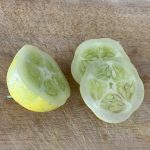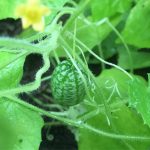- Cucumbers will do much better grown in a greenhouse or poytunnel. If you are growing them outside, be sure to choose a sunny and warm site with fertile, moisture-retentive soil.
- If you are planning to grow outside, make sure you don’t plant if there is any risk of frost or cold weather. It is best to temporarily plant in the punnets that they arrive in, or in small pots, and keep them on a sunny windowsill until the weather warms up.
- Plant 30cm apart – they will do well in grow bags, pots or planted straight into the ground as long as there is plenty of compost/organic matter
- Cucumber will naturally climb so is best planted at the base of a trellis or similar support that it can scramble up.
How to grow... Cucumber
Rocket Growing Guides

There’s nothing better than tasting a home-grown freshly picked cucumber! Cucumbers are a very good salad vegetable to grow, and often give you a surprisingly good crop.
- Cucumber Growing Guide
How to Plant Cucumber
How to Grow Cucumber
- Keep cucumber plants well watered during the summer – try to avoid the soil getting too dry in between waterings.
- If growing outside, don’t plant out until risk of frost has passed. Make sure plants are sheltered from strong cold winds in spring – you could cover plants with a cloche in the early days until the weather warms up and settles.
- The male flowers will come through first. The female flowers which bear fruit will come in a bit later with warmer weather.
- Plants will benefit from a fortnightly or monthly liquid feed once fruits start to form, especially if grown in pots.
- Prune out any leaves that are affected with mildew (see below)
Common Pests and Problems with Cucumber
- Powdery Mildew – cucumbers are often affected by mildew, particularly towards the end of the season as the weather turns cooler and damper. Cut off the worst affected leaves to allow the new healthy leaves to come through and you should be able to keep the plant reasonably healthy until late summer.
- Fruits rotting at one end – this is likely to be Blossom End Rot, which can be remedied by ensuring the plant has enough water which will allow it to absorb the right nutrients from the soil
- Yellow/discoloured leaves – Any yellow or brown patches forming on the leaves can usually be attributed to a lack of nutrients. Make sure your cucumber plants are getting enough water – the soil should be consistently moist – and use a liquid feed fortnightly once fruits start forming.
- No female flowers/fruits appearing – this is usually due to cool weather or lack of sunshine (or other conditions like drought or strong winds.) Early in the season, immature plants will produce male flowers, and female flowers arrive a little later with warmer temperatures. By late June/early July you should start to see female flowers if conditions are good. Good pollination is needed too, so be sure to leave a window or two open in the greenhouse for the bees to get in!
- Red Spider Mite – they attack the leaves of plants and suck the sap from them. This leaves a mottled appearance, and can cause the plant to drop its leaves and if severe infestations are not dealt with the plant will eventually die. Spray or mist your plants with water to maintain a more humid atmosphere, and be careful not to overcrowd plants in greenhouses. This will help to prevent an outbreak.
- Greenfly – These aphids are often a problem. To keep them at bay we recommend planting lots of companion plants – like marigolds – and providing something yellow and sticky, like a yellow bucket smeared in vaseline. Works a treat!
- Mice/Rats/Voles – if you see any teeth marks in the fruits, this is likely to be a rodent of some description..!
How to Harvest and Store Cucumber
- Cut off fruits with a sharp knife once they reach the desired size. As a general rule, younger fruit will be tastier than older, larger fruit!
- You should get a fairly continuous crop for several weeks, often through to early autumn.
- Cucumbers will keep for several days in the fridge or in a cool room at room temperature.
- You can make great pickles from cucumbers, and this is a good way to store them for longer.



